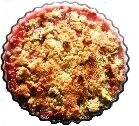How to Grow Rhubarb
Here you will, find loud and clear, details on how to grow rhubarb. There will be no mutterings and mumblings from me of rhubarb... rhubarb... rhubarb, definitely not.

Follow this advice on growing rhubarb and then you can sit around the table eating your rhubarb pies and going rhubarb... mumble, mutter, amongst yourselves.
Anyone can grow rhubarb, even mumblers (including teenagers). Even if you ignore rhubarb... it will ignore you (like teenagers), and still grow. Like family it hangs around and will be with you for years and... forever really.
However there are optimum conditions on how to grow rhubarb, so sit up straight, no mumbling and pay attention:
- Rhubarb is a perennial, sending out new shoots in early spring through to autumn, and in some areas, through winter
- Rhubarb will grow LARGE in a sunny spot. A bit of shade is ok, although it won't be quite so large. It dislikes hot and humid climates. Temperatures above 25° will hinder its growth, and much below -3° will kill off the top part at least
- A fast growing rhubarb plant needs plenty of food and water. Put new compost or animal manures, and mulch on at the end of the growing season in early winter, and if necessary give liquid fertiliser every few weeks over summer. Don't let it get thirsty, but don't let it get consistently boggy
- Buy crowns, or mumble nicely to neighbour for one of theirs, and plant in early spring, or even the previous autumn
- Divide your crowns at least every 4 years if you can. Cut between the different buds, leaving a good root clump with each division. Large rhubarb clumps left undivided often get too many baby hangers-on, crowding out the top and going nowhere fast
- When planting rhubarb, dig large holes about twice the size of a bucket at least 90cm (3ft) apart and fill with compost or good soil and fertiliser. Put crown buds 2' (5cm) below soil surface, then cover with mulch, such as leaves, grass clippings, straw etc. A very slightly acid soil is preferable for growing rhubarb
More tips on how to grow rhubarb — including the scary bits!
Too much oxalic acid is poisonous, and rhubarb leaves have it in spades. Although there's a bit in the stalks, don't forget there's oxalic acid in spinach, beets, cabbage and other vegetables.
But with a good diet, we can all handle as much oxalic acid, arsenic and traces of other poisons that nature gives us in healthy fruits and vegetables. That said, rhubarb leaves go overboard, so trim them off as soon as you pick the stems.
By-the-way, cover leaves with boiling water and let steep for a day or so, dilute 1:10 with water, add a dash of liquid soap and use as a pest spray for other plants.
Pick rhubarb stems when roughly 30cm (1ft) or more in length. Colour doesn't seem to count. Colder weather often produces red stems, or if you hanker after the red colour, find a rosy stemmed clump and ask for a crown from it, or when you divide your clump, save only the red crowns to replant.
When harvesting rhubarb, carefully hold stem near base and pull down and sideways to break it off from clump. Leave at least a handful of the inner stems and leaves to keep on providing food for the plant.
If your stems are small and spindly the first year, leave the plant to get stronger, and make friends with another rhubarb grower to hopefully get invited to share their luscious desserts.
An important tip for how to grow rhubarb successfully is, don't be greedy and eat all your rhubarb at the end of the season, you must also leave some good leaf growth on to help your rhubarb build up a strong base of crowns and roots to produce well for you next season. For the same reason, remove any seed stems as they appear.
Vegetable crumble with lashings of cream doesn't sound too mmmm, but rhubarb is botanically a vegetable, not a fruit. Whatever — most bugs don't care for it, so it's all for you!
The above words are not quite true. Very occasionally a little problem arrives, so here's a list of...
Rhubarb pests and diseases:
- Slugs and snails fancy sheltering under the big leaves, and sometimes they do get the night-time munchies, particularly on the succulent new growths
- Broad mites cause bronze patches on leaves, which can stunt growth
- Stem borers burrow down from the leaf end of the stems and cause them to collapse
- A Phytophthora fungus can cause crown rot which in turn affects the whole plant and means it collapses rotten to the core. Bad drainage is to blame for this mess
- Downy mildew fungus on the underside of the leaves can appear, often encouraged by water on the leaves
- Coloured fungal spots, such as Rust (raised rust-coloured pustules) and Leaf spot (pale tan circular spots scattered with dark spots) can appear on the leaves and stalks
For ideas on controlling pests and diseases, go to pest control.

That's all on growing rhubarb. Now for some eating. Tender new stalks can be eaten raw. They can be chopped in fruit salads or soaked in a honey and lemon juice mixture.
Stewed for 5-10 minutes in sweetened liquid they can be swirled with cream or custard, and of course are perfect in pies and crumbles. Having a clump of rhubarb in your garden is worth it for the 101 ways to eat and enjoy it... go to it!
List of Vegetables — Now you are an expert on growing rhubarb, check out more vegetables to grow.
Back to HOME page: No Dig Vegetable Garden





